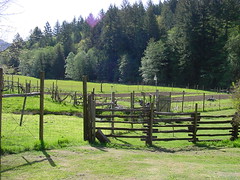Frog Snacks

The Honey Grove Valley has a resident blue heron and, in the spring, a host, a plethora, what sound like a gazillion young frogs croaking through the night. Maybe this is why we have a blue heron at all. Meal time has never been so easy, with a snack in every stream bed and standing pool of water.
When we first moved to this valley in the middle of the Coast Range rainforest, the croaking of frogs was deafening and I was sure we were surrounded by hoards of bull frogs, large and toady looking, sitting in the irrigation ditches, waiting to jump out at some inappropriate moment and make me jump in turn. Gisela laughed as I described what I imagined to be prehistoric, over-sized amphibians lurking in the dark corners of the waterways. "Why," she said, "you are only hearing a very small frog, no bigger than my thumb." She smiled and shook her head as she opened her palm and cupped it to demonstrate.
I haven't actually seen one of these frogs yet. I've tried, but there is an invisible line - at a distance of 4' the frogs will sing all night; at 3' they are as silent as if they were never there. Frankly, my eyes are not good enough, even at 3', to distinguish the frogs from the watery murk, lined with dead grass and leaves, plant life and a water dog thrown in here and there for good measure. They say the water dogs are poisonous so I doubt they fit into the snack diet of the heron. This seems a shame since they are everywhere, swimming, snoozing, crawling through the mud, probably around during the dinosaurs, part of the primordial ooze - alternatively called Oregon mud.
The blue heron does not appear to have the same problem as we do spotting the frogs. He loves to haunt our small, seasonal pond in the chicken yard. For Greg, it's a real conflict to see such a magnificent bird, probably 6 feet from wing tip to wing tip, cool gray in color and slow to lift off the ground, picking off our frogs like veritable ducks in a shooting gallery.
I think they say frogs are a true sign of a healthy environment. But, it should be added, they also make for a fat heron. There have been times when the dogs have rousted him from snacking in the waterways around the farm, and he seems to barely get off the ground in time, his long legs dangling perilously within reach. He will glide to a nearby cedar trees, land on a branch that bends under his weight, and peer down at his earth bound tormentors. It's quite a sight to see.
The Honey Grove Valley blue heron is a fixture and has been for years. Most of us assume it is a male, but just the other day we wondered why we had made this assumption. We have also assumed it is the same blue heron, but none of us know how long a blue heron lives. Is this really a decendant of the first bird we saw, and if so where is the mate? No sooner had we started to ask the questions than Allen saw two blue herons fly overhead. So, this is the deal: either there are always two birds and we can't tell which one is snacking in my frog pong while the other is fishing at the neighbor's, or the birds are loners except in springtime when love is in the air and it is time to hatch a new brood of heron to continue the tradition of large, soaring figures gliding down the valley, scouting the pools for frog snacks as they go.
Either way, there are still frogs croaking through the nights so there must be gobs of them ... or a few that make lots of noise. One heron or two in the Honey Grove Valley are not able to decimate the population. It's more like a survival of the fittest. The valley is healthy with frogs; the frogs that survive are the fittest; the heron keeps his (or her) territory in balance and, maybe this spring, there will be a nest full of heron chicks to take up where and when the parents leave off. Yum, regurgitated frog snacks for the youngsters. What better way to start off a cool, wet morning?!
(The blue heron's favorite snacking pond and runoff ditch is in the middle of this photo, but hard to see. This is a shot up the valley looking over part of the hay field and the trees in which he would roost when his frog feast was interrupted)
All Rights Reserved. Copyright 2007 Scottie Jones